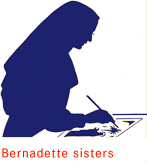
At the beginning of the 20th century, in Thaon-Les-Vosges,
in Lorraine, France, a group of young female workers, decided to secretly
devote themselves to God. These “secular virgins”, these
followers of Christ attempt as best they can to convert their co-workers
of the laundry factory, and fight against illiteracy by organizing
evening classes.
In 1905, when State and Church are legally separated, these young
women engage against secularity, and become even local heroines of
sorts, by maintaining against all odds an underground network to carry
on teaching the now forsaken teaching of forbidden beliefs (classes
organized in cellars, sisters on the look out for fear of police patrols
and police raids…). It’s probably at this period that
the militant vocation of the Bernadette sisters –as
nicknamed by the locals– developed.
In the early 30s, this religious militancy takes form and is expressed
more radically by a specific audiovisual catechism teaching method,
called the Bernadette Method. Through this teaching method, the sisters
not only intended to piously educate youth but also to use pictures
and images to fight against the pictures and images of the world (secular
press, pornography, cinema, modern art…).
The first catechism volume is a “Life of Jesus” in 150
silhouette pictures, that is 150 prints that can cover the walls of
a room. Dated 1934, this volume is designed and reproduced in stencil
technique. A few years later, due to the ever increasing number of
orders coming from French parishes and colonial missionaries the technique
changes from stencil to hand drawn ink designs which are then printed
in large numbers.
At the height of their activity, just after WWII and during the 50s,
the Bernadette community counts 40 women. As authors, the “Bernadette
Sisters” are a group of ten people, each in charge of a specific
part of the production of the prints. At the heart of it all, is the
parish priest of Thaon-Les-Vosges, Father Bogard, who chooses the
themes and Sister Mary of Jesus, who designs and draws the pictures
according to Bogard’s instructions.
This “religious art studio”, will function in that way
for a good 30 years, till 1965 at the death of Father Bogard. In 1967,
the Method is definitely forbidden by the Catholic Church. Sister
Mary of Jesus dies in 1969.
In 2006, the Bernadette sisters (who in the meantime finally became
part of the catholic Church per se and created a congregation) who
are no more than three leave their historic residence. Before leaving,
they were eager to authorize and facilitate the publication of a book
by the Editions Matières, and also donate a great number of
documents to the city of Thaon-Les-Vosges and the Nicéphore
Niépce Photography Museum in Chalon-sur-Saône (France).
In 2008, the Nicéphore
Niépce Photography Museum organised a show
on the Bernadette Method.
The bookshop and gallery Le Monte-en-l'air presented a selection of original
prints and post cards of the Bernadette Method. |
|
